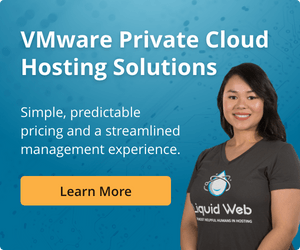Multi-Tenant vs Single-Tenant VMware Private Cloud
Cloud computing has numerous benefits and, every year, more and more companies are making the switch. The question is then — should you choose multi-tenant vs single-tenant architecture?
Due to virtualization, solutions like VMware Private Cloud bring multi-tenant environments much closer to what single-tenant ones used to be. Still, a few important differences could determine what complements your business and compliance needs better.
Let’s explore what VMware is, discuss the pros and cons of multi-tenant architecture and single-tenant architecture, and introduce a framework for deciding which one to use for your business.
What is a Single-Tenant VMware Private Cloud?
In a single-tenant cloud, all your resources and software will be hosted and run from dedicated servers while still getting the benefits of running on a virtual machine, thanks to VMware. With this setup, VMware is installed on the ESXi hypervisor on a dedicated server.
You can imagine single-tenant architecture as a business ecosystem rather than direct resource sharing — like separate buildings on the same "server" street, where each building still retains complete control over its own operations and individual offices within.
Pros of Running a Single-Tenant Environment
As such, there are lots of benefits to running your business on a single-tenant environment:
- Security: Since your data is completely separate from anyone else’s, there’s very little chance that someone can gain unauthorized access. That’s why single-tenant private clouds are considered to be very secure.
- Performance: A big advantage of single-tenant clouds is not having to share processing power with anyone, providing you with highly reliable performance at any time.
- Customization: Single tenancy gives you much more control over your environment, which includes any future customizations, hardware upgrades, and software updates.
- Backups: It’s much easier to configure proper backup and recovery processes in a single-tenant environment, as you can leave a copy of your files in a dedicated part of a server.
- Migration: With your environment in a single tenancy being isolated, you can easily move it to a dedicated server or a self-hosted setup later on.
Cons of Running a Single-Tenant Environment
With all the benefits that single-tenant architecture provides, there are also a few drawbacks you have to consider:
- Cost: Since implementing and maintaining a single-tenant environment requires more involvement and resources, it often costs significantly more than a multi-tenant one.
- Maintenance: In general, single-tenant environments often require more updates to be performed by the customer (unless using a fully managed solution).
- Efficiency: While there’s more reliability in performance with single-tenancy environments, the usage is often not maximized, leaving all the extra processing power unused.
Bottom Line: Single-tenant environments are often used by companies that need to be absolutely confident in the safety of their data and require continuous access to significant processing power.
For everyone else, the benefits of multi-tenant architecture could seem more attractive.
What is a Multi-Tenant VMware Private Cloud?

Extending the office building metaphor, a multi-tenant environment is when tenants are not buildings themselves but rather offices within the same building. Of course, each is still separate, but you can see how they would have less control over the common environment.
Pros of Running a Multi-Tenant Environment
Multi-tenant environments have proven to be very popular with smaller companies that need fewer dedicated resources due to a few key benefits:
- Low Cost: Solutions with a VMware multi-tenant design use shared resources to lower per-user cost while keeping the environment for every user separate at the same time.
- Efficiency: It’s much more likely for resources to be utilized fully in multi-tenant environments than single-tenant ones.
- Setup: Because multi-tenant environments are not as customized, the onboarding process is usually both faster and easier for everyone. Liquid Web's Multi-Tenant VMware Private Cloud has same-day availability.
- Maintenance: In multi-tenant environments, updates are usually handled by the solution provider.
Cons of Running a Multi-Tenant Environment
While multi-tenant environments provide more affordability and ease of use, some are not without limitations:
- Security: Even though multi-tenant environments are very safe, they do have more access points, which could (in theory) present vulnerabilities for cyber attacks.
- Backups: Managing backups in multi-tenant environments is much more complicated. Quite often, backups are not available at all, and even when they are, the options could remain very limited.
- Customization: Since multiple tenants are sharing the same architecture, they don’t have a lot of control over customizations or other aspects of the environment itself.
- Uptime: While every tenant in a multi-tenant environment is isolated, they could still be affected if something happens to the platform as a whole that requires a system-wide reset.
At Liquid Web, our Multi-Tenant VMware Private Cloud addresses and negates all the potential weaknesses of multi-tenant environments by integrating Acronis Cyber Backup, utilizing distributed resource servers, and ensuring high availability throughout the backend.
You can now see how, with proper configuration, a multi-tenant environment could be an excellent choice for businesses that don’t necessarily have the budget, time, or desire to handle maintenance.
How to Choose Between Multi-Tenant vs Single-Tenant Cloud Environments
Before deciding which type of private cloud you should choose, it’s essential to consider your server needs, budget, growth rate, and compliance requirements today. Multi-tenant vs single-tenant environments could be a great fit even for the same company, just at different stages of its timeline.
A great question to ask is, what are you actually trying to accomplish?
If you’re moving from a self-hosted environment to the cloud, a single-tenant environment could be a better fit and would give you more control over customization and maintenance.
At the same time, if your company is just starting out and is hosted on a shared server, moving to a multi-tenant private cloud is a great next step in your digital transformation. Most SaaS startups, for example, prefer to start with multi-tenancy.

Jake Fellows
Jake Fellows is the Sophisticated Hosting Product Manager for Liquid Web's Managed Hosting products and services. He has over 10 years experience involving several fields of the technology industry, including hosting, healthcare, and IT-system architecture. On his time off, he can be found in front of some form of screen enjoying movies, video games, or researching into one of his many technical side projects.
Keep up to date with the latest Hosting news.




